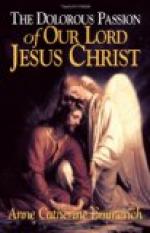In the year 1823, on Holy Thursday and Good Friday, which came on the 27th and 28th of March, she had visions of the Passion, during which blood flowed from all her wounds, causing her intense pain. Amid these awful sufferings, although ravished in spirit, she was obliged to speak and give answers concerning all her little household affairs, as if she had been perfectly strong and well, and she never let fall a complaint, although nearly dying. This was the last time that her blood gave testimony to the reality of her union with the sufferings of him who has delivered himself up wholly and entirely for our salvation. Most of the phenomena of the ecstatic life which are shown us in the lives and writings of Saints Bridget, Gertrude, Mechtilde, Hildegarde, Catherine of Sienna, Catherine of Genoa, Catherine of Bologna, Colomba da Rieti, Lidwina of Schiedam, Catherine Vanini, Teresa of Jesus, Anne of St. Bartholomew, Magdalen of Pazzi, Mary Villana, Mary Buonomi, Marina d’ Escobar, Crescentia de Kaufbeuern, and many other nuns of contemplative orders, are also to be found in the history of the interior life of Anne Catherine Emmerich. The same path was marked out for her by God. Did she, like these holy women, attain the end? God alone knows. Our part is only to pray that such may have been the case, and we are allowed to hope it. Those among our readers who are not acquainted with the ecstatic life from the writings of those who have lived it, will find information on this subject in the Introduction of Goerres to the writings of Henry Suso, published at Ratisbonne in 1829.
Since many pious Christians, in order to render their life one perpetual act of adoration, endeavour to see in their daily employments a symbolical representation of some manner of honouring God, and offer it to him in union with the merits of Christ, it cannot appear extraordinary that those holy souls who pass from an active life to one of suffering and contemplation, should sometimes see their spiritual labours under the form of those earthly occupations which formerly filled their days. Then their acts were prayers; now their prayers are acts; but the form remains the same. It was thus that Anne Catherine, in her ecstatic life, beheld the series of her prayers for the Church under the forms of parables bearing reference to agriculture, gardening, weaving, sowing, or the care of sheep. All these different occupations were arranged, according to their signification, in the different periods of the common as well as the ecclesiastical year, and were pursued under the patronage and with the assistance of the saints of each day, the special graces of the corresponding feasts of the Church being also applied to them. The signification of this circles of symbols had reference to all the active part of her interior life. One example will help to explain our meaning. When Anne Catherine, while yet a child, was employed in weeding, she besought God to root up the cockle from the field of the Church. If her hands were stung by the nettles, or if she was obliged to do afresh the work of idlers, she offered to God her pain and her fatigue, and besought him, in the name of Jesus Christ, that the pastor of souls might not become weary, and that none of them might cease to labour zealously and diligently. Thus her manual labour became a prayer.




